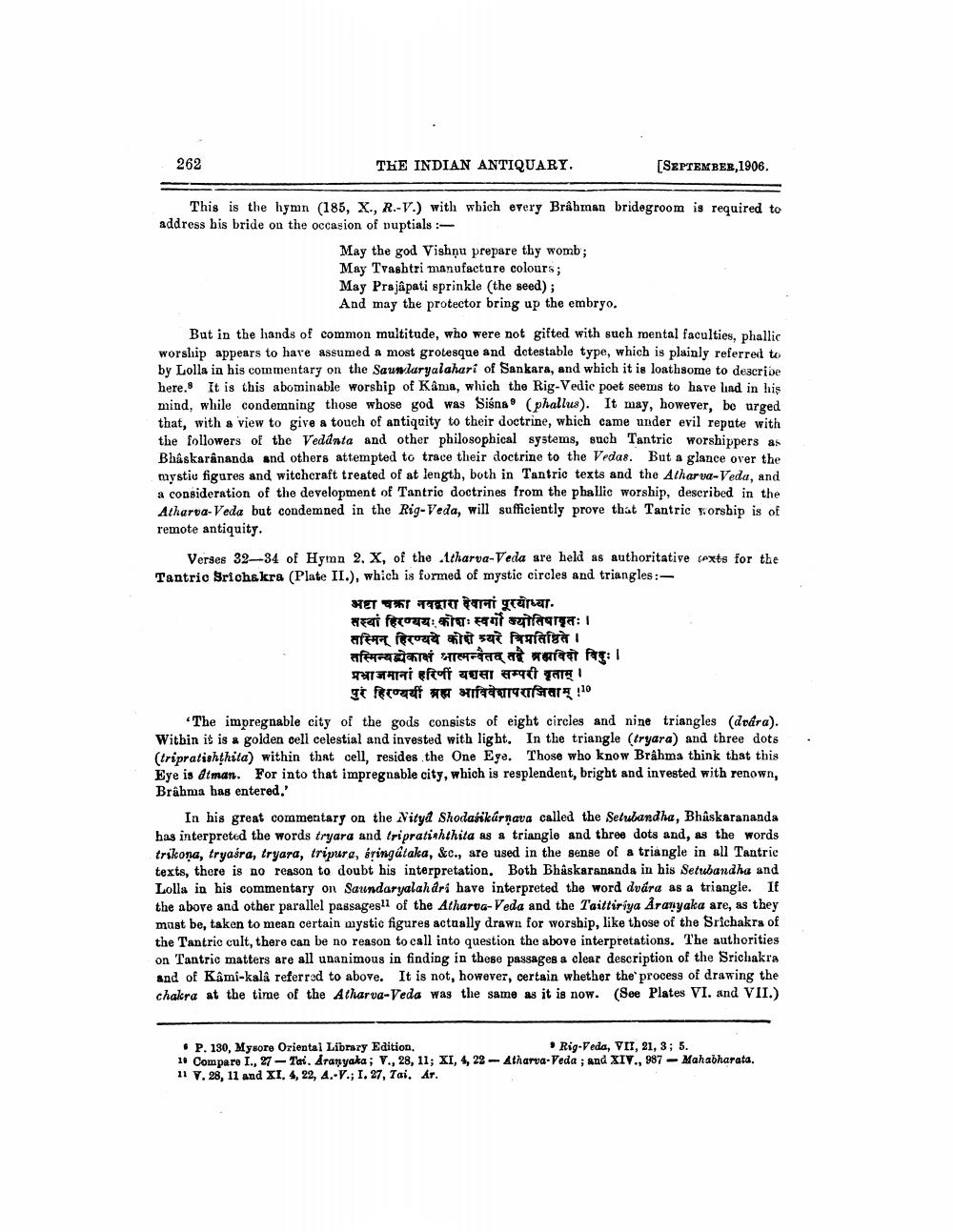________________
262
THE INDIAN ANTIQUARY.
This is the hymn (185, X., R.-V.) with which every Brahman bridegroom is required to address his bride on the occasion of nuptials:
May the god Vishnu prepare thy womb; May Trashtri manufacture colours; May Prajapati sprinkle (the seed);
And may the protector bring up the embryo.
[SEPTEMBER,1906.
But in the hands of common multitude, who were not gifted with such mental faculties, phallic worship appears to have assumed a most grotesque and detestable type, which is plainly referred to by Lolla in his commentary on the Saundaryalahari of Sankara, and which it is loathsome to describe here. It is this abominable worship of Kâma, which the Rig-Vedic poet seems to have liad in his mind, while condemning those whose god was Sisna (phallus). It may, however, be urged that, with a view to give a touch of antiquity to their doctrine, which came under evil repute with the followers of the Vedanta and other philosophical systems, such Tantric worshippers as Bhaskarânanda and others attempted to trace their doctrine to the Vedas. But a glance over the mystic figures and witchcraft treated of at length, both in Tantric texts and the Atharva-Veda, and a consideration of the development of Tantric doctrines from the phallic worship, described in the Atharva-Veda but condemned in the Rig-Veda, will sufficiently prove that Tantric worship is of remote antiquity.
Verses 32-34 of Hymn 2. X, of the Atharva-Veda are held as authoritative texts for the Tantric Srichakra (Plate II.), which is formed of mystic circles and triangles:
अष्टा चक्रा नवद्वारा देवानां पूरयोध्या. तस्यां हिरण्ययः कोशः स्वर्गे ज्योतिषावृतः । तस्मिन् हिरण्यये कोशे श्यरे त्रिप्रतिष्ठिते । तस्मिन्यद्व्येकाक्षं श्रात्मन्वैतद् तद्वै ब्रह्मविदो विदुः । प्रभ्राजमानां हरिणीं यशसा सम्परी वृताम् । पुरं हिरण्ययीं ब्रह्म आविवेशापराजिताम् ! 10
The impregnable city of the gods consists of eight circles and nine triangles (dvára). Within it is a golden cell celestial and invested with light. In the triangle (tryara) and three dots (tripratishthita) within that cell, resides the One Eye. Those who know Brahma think that this Eye is atman. For into that impregnable city, which is resplendent, bright and invested with renown, Brahma has entered.'
In his great commentary on the Nitya Shodasikárnava called the Setubandha, Bhaskarananda has interpreted the words tryara and tripratishthita as a triangle and three dots and, as the words trikona, tryaira, tryara, tripura, bringátaka, &c., are used in the sense of a triangle in all Tantric texts, there is no reason to doubt his interpretation. Both Bhaskarananda in his Setubandha and Lolla in his commentary on Saundaryalahari have interpreted the word dvára as a triangle. If the above and other parallel passages11 of the Atharva-Veda and the Taittiriya Aranyaka are, as they must be, taken to mean certain mystic figures actually drawn for worship, like those of the Srichakra of the Tantric cult, there can be no reason to call into question the above interpretations. The authorities on Tantric matters are all unanimous in finding in these passages a clear description of the Srichakra and of Kâmi-kalâ referred to above. It is not, however, certain whether the process of drawing the chakra at the time of the Atharva-Veda was the same as it is now. (See Plates VI. and VII.)
P. 130, Mysore Oriental Library Edition.
Rig-Veda, VII, 21, 3; 5.
10 Compare I., 27-Tai. Aranyaka; V., 28, 11; XI, 4, 22-Atharva-Veda; and XIV., 987- Mahabharata. 11 V. 28, 11 and XI. 4, 22, A.-V.; I. 27, Tai, Ar.




